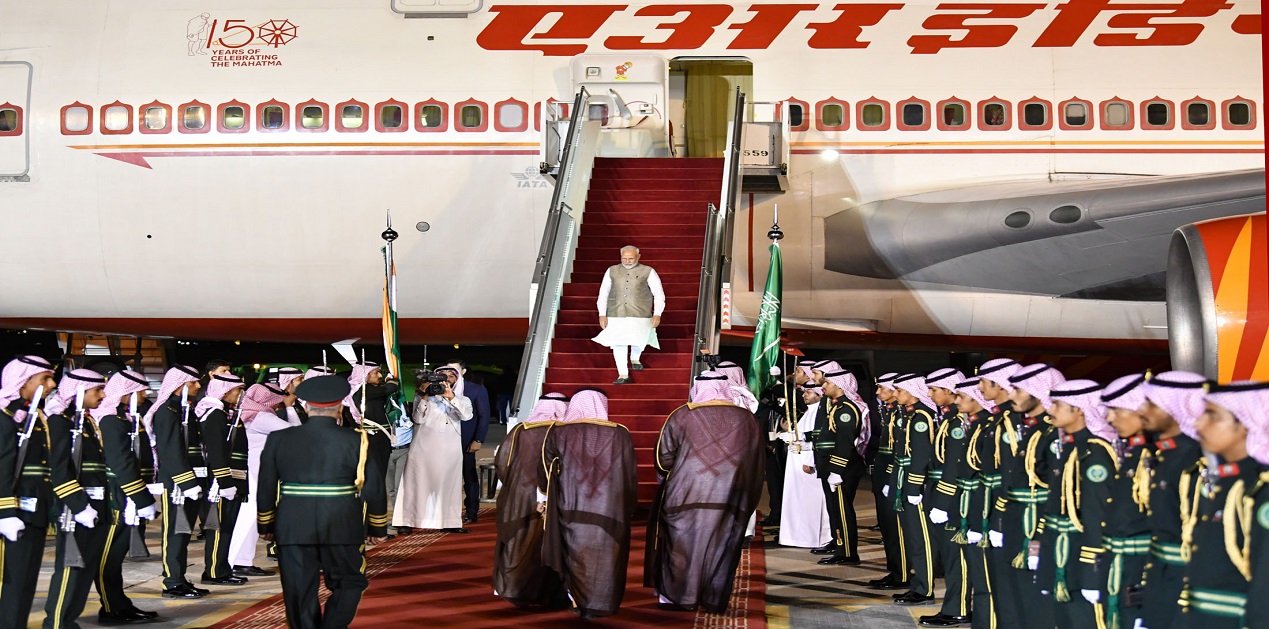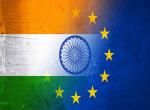Since the last few years, there has been a discernible growth in India’s bilateral relations with most of the countries in its extended neighbourhood – West Asia. With the exception of a few, cooperation and joint collaborations between them are getting more robust and comprehensive. Lately, the relations have no longer been determined only by the conduct of the traditional oil-energy trade, amount of remittances being sent back to the country, and the size of the Indian migrant workforce present in West Asia, particularly in the Gulf Cooperation Council (GCC) countries. There is a significant growth in the political relations, which has facilitated, to a great extent, an expansion of the overall ties between the two sides. For a prolonged period, this remained a weak or an insignificant ‘link’ that had stymied the prospects for progression of the relations. Tellingly, the time and energy invested by the current Indian Prime Minister Narendra Modi personally towards establishing links with the leaderships in West Asia played an instrumental role in bringing about this transformation.
For the Arab Gulf countries, in particular, which, for several decades have depended on oil/energy-based economy, they are on a path towards diversifying their sources of revenue, and this has necessitated them to explore economic opportunities in the non-oil sector, including technology, investment abroad and in the renewable energy domain. Many of the countries, therefore, are intensifying their cooperation with countries like India, which is fast emerging as an attractive partner and a potential destination for investments, technical cooperation, economic as well as defence engagements, and also to collectively work against the growing scourge of global warming and climate change. It could also be mentioned that the ‘Look East’ sort of policy adopted by most of the West Asian countries or that of Gulf’s ‘Asia Pivot’ policy, triggered by some of these factors, coalesced with the Modi-led government’s ‘Look West’ policy, which emphasises on scaling up the level of cooperation, particularly with the GCC member states, Iran and Israel. The steady improvement and gradual maturation of bilateral relations have enabled India to explore newer domains of cooperation with the West Asian partners. Due to this evolving phenomenon, bilateral activities in non-traditional security spheres, such as renewable energy, healthcare, space cooperation, are gradually becoming a few salient characteristics of India-West Asia relations.
From the standpoint of India’ energy and economic security, cooperation in these two conventional domains will continue to occupy a significant space in New Delhi’s foreign policy agenda under the current government, similar to most of the previous administrations. This is precisely because of the considerable bilateral trade which is currently being conducted, and it is noteworthy that India’s third and fourth largest trading partners, that is, the United Arab Emirates (UAE) and Saudi Arabia, respectively, are from the Gulf region alone. Now, with the signing of the India-UAE Comprehensive Economic Partnership Agreement (CEPA) in February 2022, and the introduction of India’s Unified Payment Interface (UPI) services, in some of the Gulf countries, including Oman, Qatar, Saudi Arabia and the UAE, will undoubtedly improve the economic ties. Similar is the case with Israel, with whom India’s overall relations have seen a massive growth, extending well beyond their longstanding military-security ties and defence trade. Today, both the governments are taking up several key measures to enhance cooperation and build partnerships in areas, including renewable energy, food security, agriculture, water management, artificial intelligence, semiconductors, space, and healthcare and so on. Alongside this, efforts are also being made to enhance engagements in the socio-cultural sector, by placing importance towards strengthening people-to-people connect, academic exchanges and collaboration, boosting tourism cooperation, etc. A major impetus to the ties will be provided as and when these two countries sign the Free Trade Agreement (FTA), which is in the advanced negotiation stage.
Given the magnitude of India’s crude oil and energy imports from West Asia since last few decades, exporters of these strategic commodities from the region will continue to play important roles in New Delhi’s quest for energy security, regardless of its diversification strategy. But importantly, India has begun to forge cooperation with a few countries in the renewable energy sector, which is a timely development. The mutual realization of an urgency to lessen the reliance on fast-depleting fossil fuel energy resources, imperative requirement to cut down the rate of carbon emissions and also to mitigate challenges emanating out of environmental degradation (as a result of rapid climate change) have resulted into India and its key West Asian partners giving priorities towards the development and deployment of renewable energy and related technology. Like India which has set a target to achieve 450/500 gigawatts of renewable energy installed capacity by 2030, a few West Asian countries have ambitions to make such transitions to clean energy sources, mainly solar power and hydrogen. In particular, Israel, Saudi Arabia and the UAE have started to take initial steps to engage with India in this area. These efforts have clearly indicated the centrality of renewable energy for sustainable developments not only for these countries but have also become an important trend in the emerging world order. An intensification, therefore, in their technological collaborations in this area can be expected in the upcoming period, and will likely see more involvement of both state and private-owned stakeholders, also generating more job opportunities for both the citizens.
Going beyond the traditional realms of cooperation, a need for engagement in the healthcare sector has been reinforced by the outbreak of the global COVID-19 pandemic in late 2019 from China, which engulfed almost every part of the globe. There, however, exists a huge potential to upgrade the cooperation in this sphere as India has already signed bilateral institutional agreements with a few countries. For instance, there are health/medical-related Memorandums of Understanding (MoUs) India has inked with Oman (February 2018), Jordan (March 2018), Israel (January 2018 for homeopathic medicine; December 2020 on Health and Medicine), and Saudi Arabia (October 2019). Further, there is an ongoing cooperation with UAE, both at the bilateral and plurilateral levels, and possibilities are also being explored with Bahrain as well. Taking a step ahead, India and the UAE are jointly working towards establishing healthcare projects in two key African countries – Kenya and Tanzania, and such arrangements could be worked out with other countries as well. In the light of these developments, existing agreements have encouraged cooperation in a wide range of fields, including health, medical science, medical education, and research, as well as the establishment of joint working groups for smooth and regular discussions on these issues. It is significant that India’s bilateral ties have now been extended to multifaceted aspects of healthcare and medical sciences. Priorities need to be given in the co- production of medicines, funding of research projects, exchange of research papers on various diseases/illness, regular exchanges of professionals between institutes and laboratories, and sharing and exchanges of best practices. Health crisis like the COVID-19 is a serious non-traditional security threat that cannot be ignored any longer, and cooperation in this domain should be one of the most important foreign policy objectives of every country, let alone India and the West Asian countries.
A relatively new domain which has tremendous potential to see further growth is the space cooperation. Prospects for joint collaborations in this domain have coincided with visible growth with regard to science and technological advancement attained by the UAE and Saudi Arabia from the Gulf region, and Israel. For instance, India’s Indian Space Research Organisation (ISRO) and Israel Space Agency (ISA) have engagements in activities pertaining to earth observation, space science, satellite navigation, space situational awareness, human space flight. It has been more than a decade since both these countries have been collaborating in the space sector. Simultaneously, the breakthroughs made by the UAE in the recent years in space technology offer favourable opportunities for India to elevate its technological partnership with the concerned Emirati authorities. The 2016 MoU between ISRO and the UAE Space Agency (UAESA) should facilitate an expansion and take the ties to newer heights.
Similarly, Saudi Arabia’s increasing focus on developing its own space technology, within the framework of its Saudi Vision 2030, should push Riyadh to seek assistance from foreign countries like India that have already achieved a considerable degree of experience in space science. There is already a MoU between ISRO and King Abdul Aziz City for Science & Technology (KACST), signed in early 2010, but inactivity in this sphere runs contrary to the exponentially growing ties between the two countries. Having said this, certain efforts with the UAE and Saudi Arabia have been taken up during late 2022 and early this year, when delegations from ISRO visited these two countries to explore means for strengthening ties. For now, potential areas of cooperation include remote sensing, satellite communication, and satellite-based navigation. Tellingly, as forming ‘mini-lateral’ engagements with like-minded member countries have become a new pattern, India should explore the possibility of establishing a trilateral or even quadrilateral collaboration, involving the UAE, Israel, France and Japan, in projects related to space technology. The similarity in the quest for technological advancement on both sides could act as a catalyst and, in the long run, space cooperation could emerge as new momentum that could continue propelling the already-flourishing Indo-West Asian ties.
While the Indo-West Asian bilateral ties are on an upward trajectory, there are a few potential challenges which New Delhi cannot afford to overlook. One of the most pertinent challenges is the existing uncertain security situation in the region, mostly the unabated antagonism between Iran and Israel. India also needs to closely monitor the volatile security developments, regardless of the recent Saudi-Iranian reconciliation deal which is expected to deescalate the tensions in West Asia. Any instability in West Asia could give rise to undesirable socio-economic as well as security consequences for India and the region. A stable West Asia is crucial for India, mainly considering its rising socio-economic and security stakes, presence of large Indian expatriate community (including migrant workers) as well as the country’s increasing investments there. Secondly, the increasing Chinese strategic footprints in West Asia, in the long run, could pose a challenge to India’s interests in the region. Both countries, for now, are making unrelenting efforts to secure their respective positions in this energy-rich region, and, therefore, a stiff competition between them in the investment, economic, energy and development sectors could be in the offing. China’s partial political role in brokering a normalisation deal (in March this year) between two once-arch-rivals – Iran and Saudi Arabia – is expected to give certain advantage to Beijing to increase its presence, both bilaterally and regionally. As a result, it is imperative for India to keep the momentum intact and make strenuous efforts to further strengthen its ties bilaterally as well as with the regional forums/organisations/blocs. Thirdly, India cannot be complacent in executing the agreements and pacts which have been signed bilaterally, trilaterally and multilaterally, lately. Delays and lackadaisical approach in this regard would only hamper the progression of the ties. Countries like Israel, the UAE and Saudi Arabia, with their action-result-oriented policies, would look for efficiency while dealing with their partners. India, therefore, should be mindful of the professionalism of these countries which are witnessing considerable progression in almost all the fronts. India’s non timely activities and deliveries (if any) could make the West Asian countries turn towards other extra-regional players, including China, which looks for every possible opportunity to widen its presence.
Notwithstanding the aforementioned challenges, the current India-West Asia relations are on a satisfactory trajectory. That most of the bilateral ties have become comprehensive than how they used to be until a decade or so ago speaks a volume about the efforts being given by the current political dispensation in New Delhi and vice versa. There is a visible display of realpolitik in the conduct of the respective foreign policy of India and the West Asian partners, and their converging strategic interests are instrumental in bringing the countries closer. Further, the emerging geopolitical churnings in West Asia could also open avenues for establishing multilateral partnerships between like-minded countries. Simultaneously, India should be cognisant of the fact that the realignment of relations in the region has also opened the doors to other extra-regional players, including Russia and China. This also means that there are possibilities for more competition amongst the countries. India, therefore, should take advantage of its growing profile in the region and start mulling over having a West Asia-centric strategy, that is, to deal with the region holistically and not only bilaterally. Alongside its bilateral meetings, it is high time that New Delhi starts engaging, annually or biennially, with forums like the Arab League and the GCC to have a better understanding of the regional dynamics under a single platform. Finally, based on strategic, economic and national interests, it would be also prudent to explore the possibility of forming issue-based ‘mini-lateral’ partnerships with countries from West Asia.
(The paper is the author’s individual scholastic articulation. The author certifies that the article/paper is original in content, unpublished and it has not been submitted for publication/web upload elsewhere, and that the facts and figures quoted are duly referenced, as needed, and are believed to be correct). (The paper does not necessarily represent the organisational stance... More >>
Image Source: https://www.pmindia.gov.in/wp-content/uploads/2019/10/H2019102979233.jpg











Post new comment